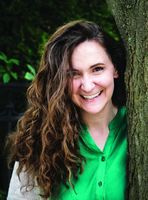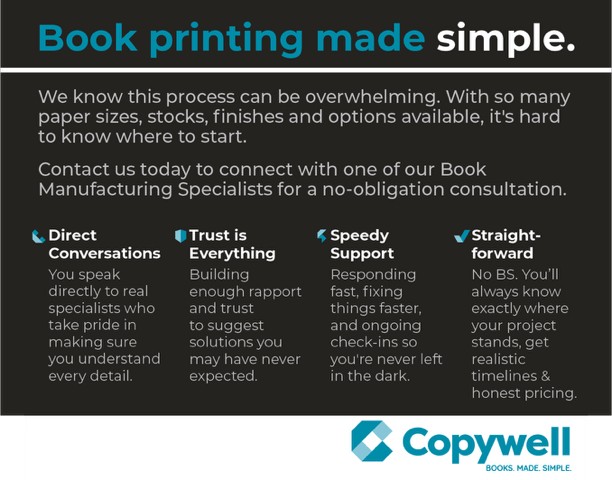"This Was the Perfect Time for Me to Tell the Story" Amanda Leduc Talks Fairy Tales, Disability, and Progress in Her New Book
The often-problematic role of disabled people in fairy tales hasn't been widely studied, but author Amanda Leduc's new book Disfigured: On Fairy Tales, Disability, and Making Space (Coach House) is determined to fix that.
Citing examples ranging from The Brothers Grimm to Disney, Leduc delves into how disability is portrayed in these classic stories, and the damage it has done to our public perception of disabled people to this day. Tearing down the harmful cliches and inconsistencies of the past, Disfigured also points to a brighter future: one where new and inclusive fables are created to mirror the real-world successes of the disability rights movement.
We're absolutely thrilled to have Amanda at Open Book today, where she discusses the importance of letting a story take it's own shape, how diving back into her deep pool of research allowed her to get creatively unstuck, and how the progression of her book began to match her own journey of personal growth as a disabled woman.
Open Book:
How did your memoir project first start? Why was this the right time to tell your story?
Amanda Leduc:
The idea for Disfigured came about, in part, as a result of a walk that I took in a forest at Hedgebrook Farm on the west coast in the summer of 2018. I was moving through the forest, walking stick in hand, and found myself thinking about how we so often associate the forest with stories that are magical and otherworldly—while also carrying an implicit understanding that forests, inaccessible as they are, are never a place where you’d expect to find disabled people. And yet, at the same time, our magical fairy stories are inundated with disabled people in so many shapes and forms. I realized this as I walked through the forest and was so struck by the connection that I resolved to write an essay about it. I was pretty certain—since the connection seemed so obvious—that this had been written about before, so my plan was originally just to write an essay about it, and perhaps pitch the essay to Open Book!
But when I got home and started to do more research on disability in fairy tales, I discovered that there wasn’t as much out there as I’d thought. I continued to dig, and the ideas continued to grow—and eventually, I had enough material for a book, so I pitched the idea to Coach House, and now here we are.
This was the perfect time for me to tell the story because I’ve finally arrived at a place of true disability pride in terms of my own identity as a disabled woman. I wouldn’t have been able to write this same book even five years ago, so to see the progression of Disfigured and how it came about—and to realize how the progression of the book mirrors my own growth in confidence and strength—has been nothing short of magical.
OB:
Did your memoir change significantly from when you first started working on it to the final version? Was there anything that surprised you about the process?
AL:
I think I had originally conceived of the book as being more in the vein of cultural criticism and less of a memoir. In one of my initial meetings with Alana Wilcox at Coach House, I handed over an outline and I remember being really nervous about it—wanting to make sure that it covered everything about fairy tales that I wanted to explore, etc. Alana, by contrast, was much more relaxed about things, and assured me that the outline itself would probably change a great deal by the time the book was finished.
Your CanLit News
Subscribe to Open Book’s newsletter to get local book events, literary content, writing tips, and more in your inbox
She was right. I’m still a fan of outlines—if for nothing else other than they’re something to give me the illusion of a process!—but writing this book has taught me to be more relaxed about the ways that stories take shape, even (perhaps especially) when those stories are dealing with real-world and real-life details.
OB:
What do you do if you're feeling discouraged during the writing process? Do you have a method of coping with the difficult points in your projects?
AL:
Usually when I’m feeling discouraged with a project, I put it aside and try to focus on something else for a while—I read, or I take the dog for a walk, or I go to the kitchen and make something delicious. With Disfigured, I found that going back to the research actually helped me tremendously when I hit a writing snag. Usually when I write fiction, I always come up against a plot roadblock—what happens now? is a common question for me. But whenever that happened with this book, I found that I didn’t actually have to set the project aside. Instead I went back to the research and let myself get drawn into another rabbit hole of fairy tales and picking them apart. Inevitably, this would spark something of interest in my head and I’d happily get back to writing.
It’s been a great lesson, and one that I hope I can use in my fiction projects going forward too!
OB:
Did you use any materials, documents, interviews, or other research that became part of the writing process?
AL:
Yes, absolutely! Disfigured is a compendium of first-hand interviews, medical notes, book research, and hundreds of hours of online research. Doing research for the book was actually one of my favourite things about it—so many things that I uncovered in the course of researching the book were unbelievably interesting. I wanted to include everything!
OB:
Did you experience any anxiety about making a part of yourself public in this way? If so, how did you or do you cope with the vulnerability of publishing a memoir?
AL:
It might sound strange, but I didn’t really experience any anxiety in the course of writing the book. This might change once I’m actually out there talking about it, but one of the key things for me in writing creative non-fiction is the recognition of how the finished product is very much a piece of craft in and of itself. That is, when I tell a true story on the page, it is true, but it’s also packaged and crafted in a way that makes it different from the actual experiences of my past. So there’s a certain element of remove for me once an essay or piece or book is out there in the world.
At the moment, the vulnerabilities that I have around this book are similar to the vulnerabilities I felt around my first novel when it came out—will people like it, will they think it’s terrible, will they think I haven’t done enough research? What if I tell the story of Hansel and Gretel wrong? (There are, after all, many different versions of the tale!) I’m oddly feeling much less anxious talking about the personal aspects of the book. I think part of that has to do with the fact that so much of the personal journey in the book is about moving to a kind of emotional strength and recognition of the power in my life as a disabled woman. Now that I’ve arrived at that place, I want to be as open and honest about the journey as I can be so that other people making a similar journey might know that they aren’t alone, and hopefully find strength and solace in what Disfigured is trying to do.
OB:
Personal essays, memoirs, and creative non-fiction in general have becoming particularly in demand and loved by readers in recent years. Why do you think creative non-fiction is more popular than ever?
AL:
I think we’ve always looked to literature as a way to connect with others, and there’s something particularly captivating about reading creative non-fiction because it invites a connection not only with a character, but also an actual person out in the world. Creative non-fiction that’s well done makes a connection between the reader and the writer that both exposes and nurtures vulnerability—the vulnerability of the writer as well as the vulnerability of the reader, who is allowing themselves the opportunity of growth and change through listening to the experience of someone else.
For myself as a writer and a reader, I find the risks deployed in creative non-fiction to be incredibly compelling. I am enthralled with the ways that the best voices working in creative non-fiction today use the CNF tools of self-examination to interrogate both themselves and the world.
OB:
What are you working on now?
AL:
Usually when I finish a project, I find that I inevitably start a project of a different genre. I finished Disfigured in the fall of 2019, and then went to work on edits for my novel, The Centaur’s Wife, which is hopefully coming out in the Spring/Summer of 2021. Those are also done now, and I find myself intrigued by ideas for two new projects—one fiction, and one non-fiction! The fiction will likely be a novel-in-short-stories about hyenas that walk and talk. And I think the non-fiction work will be another memoir/research hybrid, potentially about vibrators, God, and female desire. All the best parts of our animal selves.
_________________________________________________
Amanda Leduc is a disabled writer and author of the non-fiction book DISFIGURED: ON FAIRY TALES, DISABILITY, AND MAKING SPACE, out now with Coach House Books. She is also the author of the novel THE MIRACLES OF ORDINARY MEN, published in 2013 by ECW Press. Her new novel, THE CENTAUR’S WIFE, is forthcoming with Random House Canada in the spring of 2021.
Her essays and stories have appeared in LitHub, The Rumpus, Little Fiction | Big Truths, The National Post, Open Book Ontario, and other publications across Canada, the US, the UK, and Australia. She has previously been longlisted for both the CBC Nonfiction Prize (2019 and 2014) and the CBC Fiction Prize (2014), the StoryQuarterly Fiction Prize (2015), the Thomas Morton Memorial Prize in Fiction (2015), the Edna Staebler Personal Essay Contest (2014), and the 2007 PRISM International Short Fiction Contest. She is represented by Samantha Haywood at the Transatlantic Agency.
Born in British Columbia, she has lived in Ontario, England, BC, and Scotland. She has cerebral palsy and presently, she makes her home in Hamilton, Ontario, where she lives with a very lovable, very destructive dog and serves as the Communications and Development Coordinator for the Festival of Literary Diversity (FOLD), Canada’s first festival for diverse authors and stories.





